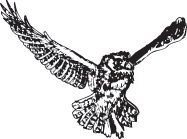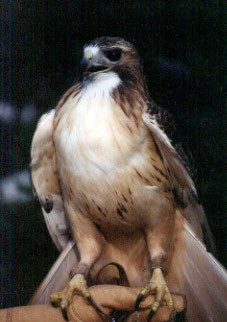

Red-Tailed Hawk
(Buteo jamaicensis)
Buteos are the largest group of hawks. They have long, broad and rounded wings and short, broad tails. They are able to soar for hours but they usually hunt by the “sitting and waiting” from a tree or utility pole. They eat a wide variety of prey but mice make up the major part of their diet.
Red-tailed Hawks are the largest and most powerful of our eastern Buteos. Males are usually smaller than females. They perch in conspicuous places such as dead trees and utility poles. At times when there are strong winds they are able to kite, hang motionless in mid-air, while hunting.

Red tails mate for life. Their nests are constructed of coarse sticks thrown together, 30 to 40 feet above ground in the crotch of a large tree. The nest is lined with inner bark strips, evergreen sprigs and green leaves. The pair usually only produces one brood per year of two to four dull white eggs. The young are blind, downy and helpless when hatched. Young birdshatch several days apart, asynchronously.
Red tails feed mainly on mice, rabbits, chipmunks, squirrels, insects, snakes and some carrion.
Their spring migration is during March, April and May while autumn migration is in September through December and travel south as far as Panama. Red tails are the most widely distributed, most universally common, and best known of all our hawks. Many adults remain in their territory throughout the year. The Eastern population has been in a decline due to early bounty hunting, human persecution, habitat loss and some egg-shell thinning from hard pesticides in their food chain.
Common enemies today include great horned owls, raccoons and humans.